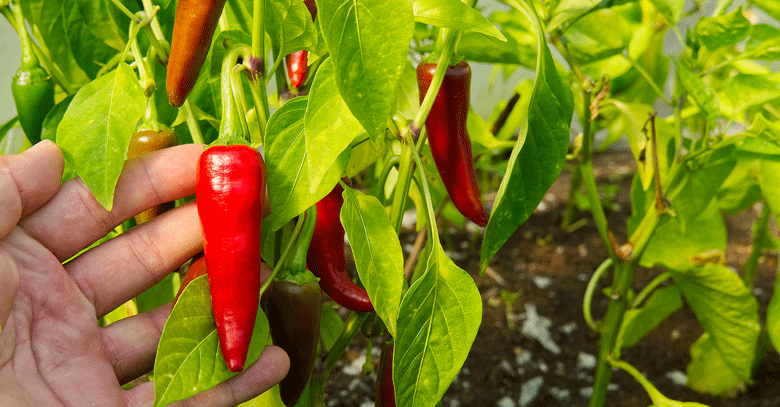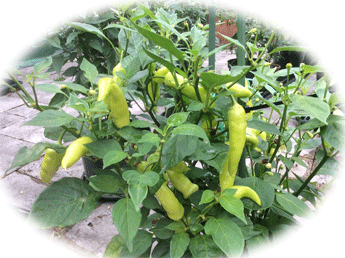How to identify Chilli plants
In my previous post I mentioned that I had already had my first Chilllies from a plant that I overwintered from last year. Because this plant was still indoors when its first flowers appeared, I did some self-pollination (the chances were slim that the bees would do it indoors). I did the pollination with a soft watercolour paint brush by transferring pollen from one flower to the others. I was thrilled when a couple of weeks later I was rewarded with my first couple of Chillies of the season.
But I had a problem. I had no idea what type of Chilli this is. Out of pure curiosity , I decided that I wanted to try to identify it
How I identified my plant

Examine the plant and take notes
I started off this exercise by looking at the plant and taking notes. Bearing in mind that this is an overwintered plant I could only get part of the picture. For instance, because it was cut back for overwintering. I had no idea of what size if had previously been. This is where a bit of deduction and guesswork came in handy.
I guessed it had probably been a larger plant because of the size of the pot it was planted in. I always pot-on Chillies that have the potential to grow over three foot tall into 10 inch (sometimes even bigger) pots. This ties in with the size of the pot that this Chilli is in.
 In other circumstances, had it been in a smaller pot, it would have more likely been a dwarf cultivar. Smaller pots are used for dwarf cultivars because this is all they need to optimally develop their root ball. This was certainly not the case with this plant.
In other circumstances, had it been in a smaller pot, it would have more likely been a dwarf cultivar. Smaller pots are used for dwarf cultivars because this is all they need to optimally develop their root ball. This was certainly not the case with this plant.
When identifying Chilli plants, sometimes you just have to do educated guesswork.Every little bit of information helps, particularly if your narrowing down starts running out of options. This is certainly something that can happen!
My gut feeling when looking at the flowers of the Chilli is that it fell into the Capsicum Baccatum species. The flowers of Capsicum Baccatum are quite distinct. It makes this species easier to identify. Chillies that fall under this species include the Aji Amarillo (Peru’s most popular Chilli), Aji Limone ( also known as the Lemon drop Chilli), Pitanga (a starfish shaped Chilli from Brazil), Bishops Crown (A Chilli shape like a bishops hat), Aji Andean, Aji Ayucullo ( from Peru), Aji Benito (from Bolivia), the Aji Catatenango ( from El Salvador), Aji Brown ( also from Peru) and the White wax Chilli
However, more research is needed to narrow things down even more
Findings and conclusion

What did I find?
Armed with my notepad and a keen eye ,I examined the plant and found the following:
- The Chillies were light green (almost yellow) in colour . They hadn’t yet ripened
- The biggest Chilli on the plant was about 2 inches in length . It was about an inch thick. ( There are others , just smaller)
- The Chillies taper to a point and have slightly wrinkled skin. They hang downwards ( a common Capsicum annuum trait).
- The skin seems fairly thick
- The plant has white flowers with a yellow colour at the base of their corolla (petals on the inside).
- The flowers are in clusters on the nodes, rather than being single
- The leaves are oval/ teardrop shaped
- The leaves are dark green. They are not hairy (an indication that it might have fallen under ( Capsicum pubescens)
- The packet that they came in indicated it might have contained Hungarian Hotwax or Yellow Hot Wenks
My assumption at this point was that the plant could be a Hungarian Hot Wax. My research however came up with a different answer 
What my research revealed
- I determined that the Hungarian Hotwax falls under the Capsicum annuum species
- Capsicum annuum Chillies have white flowers that grow singly. That ruled out this species for this plant. Its flowers are in clusters of two to three per node. It , thus , couldn’t be a Hungarian Hotwax
- A picture of a flower I found on the web seemed similar to the flowers on the plant. This verified the Capicum Baccatum gut feeling I had
- Capsicum baccatum Chillies hang downwards and have white flowers with a green or gold coloured corolla. (This tied in with my plants flowers)
- Capsicum baccatum leaves are Ovate-lanceolate . This means shaped like an egg / head of a lance. (That’s about right for the leaves on this plant.)
- Images on the web leads me to believe this to be an Aji Chilli. These Chillies are found in Peru, Bolivia, Brazil and other South America countries
My conclusion
Tying the visual images of the Chilies on the plant with the above I believe that I identified this Chilli plant as a Lemon Drop Chilli (aka Aji Limon). A fine Chilli indeed
The Aji Limon is a staple in Peru. It is the favourite of Peruvian chefs who make dishes like Ceviche with it . The Aji Limone has a citrus note and its mildly pungent, making it ideal for this type of cuisine. It has a Scoville heat rating of 15000 to 30000 SHU.
Note
There are many other species of Chillies. This method of identifying Chillies is based on the premise that the plant you are attempting to identify is one of the five domesticated species. These are the Chilllies that you are most likely to come across when growing capsicums
Image credit Richard Elzey / CC BY 2.0 / via Flikr
